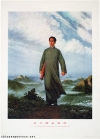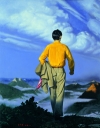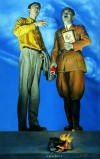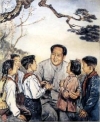
Illustration:
ill. 5.38
Author:
Ye Qianyu (1907-1995) 叶浅予
Date:
1963 (propaganda version of 1959)
Genre:
poster, propaganda poster
Material:
internet file, colour; original source: poster, paper, colour
Source:
Ye Qianyu, The Liberation of Beiping, 1959, propaganda poster version, 1963 (DACHS 2009 Rethinking Cultural Revolution Culture, Ye Qianyu) , Heidelberg catalogue entry
Courtesy:
University of Westminster Chinese Poster Collection
Keywords:
Mao Zedong, propaganda poster, foundation of the People’s Republic of China, traditional painting styles, traditional iconography, masses, Mao portrait
Ye Qianyu: The Liberation of Beiping (Ye Qianyu: Beiping jiefang 叶浅予: 北平解放)
The Liberation of Beiping 北平解放, disseminated as a 1963 propaganda poster based on a image produced for the ten-year celebrations of the founding of the People’s Republic of China in 1959 by Ye Qianyu 叶浅予 (1907-1995) illustrates the 1949 event by showing a mass ralley, featuring many images of Mao—and a few of Zhu De 朱德 (1886-1976), too. The poster makes use of traditional iconography: the faintly coloured clouds in the background, as well as the stylized and ornamental temples, pagodas and trees form a wholly untypical backdrop if compared to Cultural Revolution MaoArt.
Yet, the procession is led by an army wagon with Mao’s picture set up upon it, a characteristic “venerating curtain” around it. Furthermore, Mao’s picture appears at least 8 times in the entire image, in different sizes. Zhu De, on the other hand, appears only about 3 times. The size of the images of Mao and Zhu stands out by contrast with the minuteness of the people taking part in the procession. Here, too, as in the 1968 gouache seen earlier (ill. 5.4), the only thing to be made out clearly are these portraits, and among those, Mao’s are much more prominent (not only in terms of numbers but also of clarity) than Zhu’s.












































































































